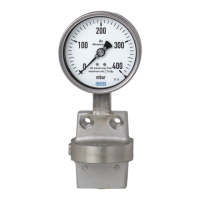7WIKA operating instructions pressure gauge model 7 per ATEX
2080284.08 02/2021 EN/DE/FR/ES
EN
Maximum surface temperature
The surface temperature of the instruments mainly depends on the medium
temperature of the application. For determining the maximum surface tempera-
ture, besides the medium temperature also other inuences such as the ambient
temperature and, if applicable, the solar irradiation must be taken into account.
Potentially explosive gas atmosphere
Required temperature class
(ignition temperature of
gas or vapour)
Maximum permissible medium temperature
(in the measuring system)
Unlled instruments Filled instruments
T6 (T > 85 °C) +65 °C +65 °C
T5 (T > 100 °C) +80 °C +80 °C
T4 (T > 135 °C) +105 °C +100 °C
T3 (T > 200 °C) +160 °C +100 °C
T2 (T > 300 °C) +200 °C +100 °C
T1 (T > 450 °C) +200 °C +100 °C
Hazardous dust atmosphere
For dusts, the procedure specied in ISO/IEC 80079-20-2 for determining the
ignition temperature has to be applied. The ignition temperature is determined
separately for dust clouds and dust layers, respectively. For dust layers, the
ignition temperature depends on the dust layer thickness per IEC/EN 60079-14.
Ignition temperature
of dust
Maximum permissible medium temperature
(in the measuring system)
Dust cloud: T
cloud
< 2/3 T
cloud
Dust layer: T
layer
< T
layer
− 75 K − (reduction depending on the layer thickness)
The permissible maximum medium temperature must not exceed the lowest
determined value, even in case of a malfunction.
Explosive atmosphere consisting of hybrid mixtures
The instruments must not be used in areas in which an atmosphere consisting of
explosive hybrid mixtures (dusts mixed with gases) can occur.
2. Safety

